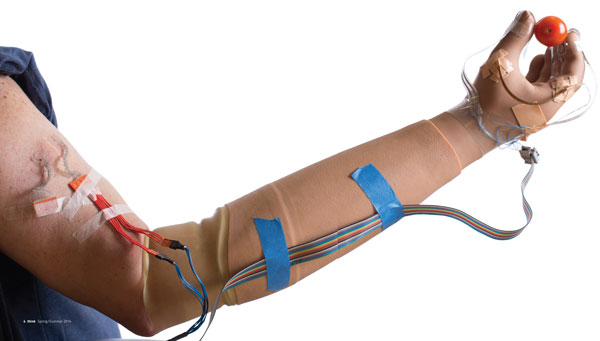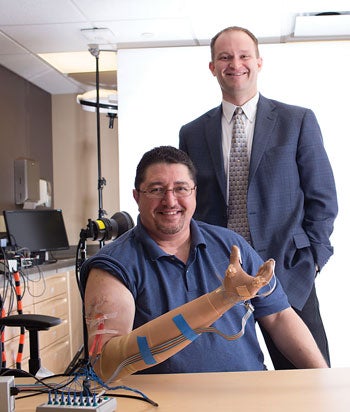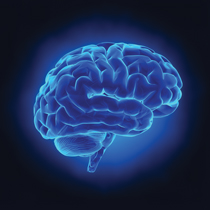launch
Restorative Touch
by Kevin Mayhood
 photo: Russell Lee
photo: Russell Lee
An industrial accident took Igor Spetic's right hand as well as something he'd always taken for granted: the ability to feel what's in his grasp.
Now, a team led by Dustin Tyler, an associate professor of biomedical engineering, is giving Spetic back a sense of touch. Using Tyler's system, Spetic can hold something as delicate as a cherry tomato without losing a drop of juice.
Participating in the groundbreaking trial study "is one of the best things I've done," Spetic says. "It's given me a sense of purpose after the accident."
Four years ago, a manufacturing machine crushed Igor Spetic's right hand beyond repair. It was his dominant hand—the one he used to produce elegant writing, grip a tool and caress his wife's face.Today, Spetic is a participant in research that creates a new connection between the human brain and a prosthetic hand—and, most important, provides him a sense of touch.
"We're kick-starting circuits that have been disconnected," says Dustin Tyler, PhD, an associate professor in the Department of Biomedical Engineering who leads a seven-member team.
 photo: Russell Lee
Igor Spetic (seated) and Dustin Tyler
photo: Russell Lee
Igor Spetic (seated) and Dustin Tyler
During the first test in May 2012—done in the Advanced Platform Technology Center, an initiative of the university and the Louis Stokes Cleveland Veterans Affairs (VA) Medical Center—Tyler and Spetic realized the technology could be life changing.
Three weeks earlier, surgeons Michael Keith and J. Robert Anderson, both from Case Western Reserve School of Medicine and Cleveland VA, had implanted tiny electrode-laden cuffs around nerve bundles within Spetic's arm. Insulated wires run from the cuffs inside Spetic's forearm up and out of his upper arm.
When in the lab and hooked up to sensors, Spetic can feel 19 distinct locations in his fingertips, palm and the back of his hand. Electric pulses sent through the wires feed signals to Spetic's brain. It's as though his prosthetic hand actually "feels" touch.
Tyler, who also is a principal investigator at the VA, acknowledges the machine's signals likely differ from nature's. Even so, he adds, "the brain is amazing; you don't have to be exact, just close enough."
Without the connected wires, Spetic must watch his prosthetic hand to know when it's holding an object. With them, even blindfolded, he not only "senses" the object, but gets a remarkably precise feel: He can grasp a small tomato—or pluck the stem from a cherry—without losing any juice.
For now, this extraordinary experience is limited to the lab. But Tyler hopes to develop an implantable system that Spetic can test at home within five years.
Spetic is not a veteran, but is committed to participating in the research long term to help others with devastating injuries—including patients at the VA. The U.S. Department of Veterans Affairs has provided funding for the research.
"My biggest fear, especially for the amputees who may be helped in the future, was that the ability to feel would fade," Spetic says. "But in two years, every day I come in here, I feel more." —Kevin Mayhood
Learn more:
About Associate Professor Dustin Tyler
Read More
Exploring the Brain
-
Cultivating Creativity
Brain scans show power of compassionate coaching.
-
Looking Within
New imaging techniques could spur better treatments.
-
Going Deep in the Brain
Locating best place to deliver electrical stimulation.
-
Restorative Touch
Giving man with prosthetic hand the ability to feel what's in his grasp.
-
Fearless
Alumna Lisa Beth Allen (WRC '83) shares what life is like after traumatic brain injury.
-
Cultivating Creativity
Brain scans show power of compassionate coaching.
-
Looking Within
New imaging techniques could spur better treatments.
-
Going Deep in the Brain
Locating best place to deliver electrical stimulation.
-
Restorative Touch
Giving man with prosthetic hand the ability to feel what's in his grasp.
-
Fearless
Alumna Lisa Beth Allen (WRC '83) shares what life is like after traumatic brain injury.






